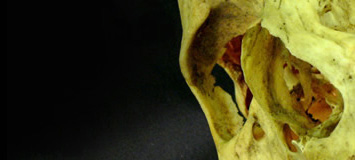Method Background and Overview
Overview
Craniofacial identification methods are used to assist the identification of skeletal remains via the analysis of skulls and faces. This may involve the overlay of a face on a skull in an attempt to determine if a match exists between the two (craniofacial superimposition), or the prediction of a face from the skull (facial approximation; see Fig. 1). Both methods are underpinned by knowledge of human anatomy, 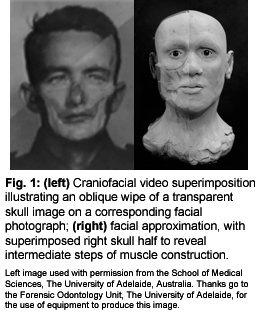 despite their use of different technical protocols. Craniofacial superimposition and facial approximation are subsumed within the discipline of physical anthropology (see Krogman and Iscan, 1986; Montagu, 1941; Reichs, 1998; Stewart, 1979). Artists have commonly been called upon to assist with sculpting or drawing tasks when undertaking the latter method.
despite their use of different technical protocols. Craniofacial superimposition and facial approximation are subsumed within the discipline of physical anthropology (see Krogman and Iscan, 1986; Montagu, 1941; Reichs, 1998; Stewart, 1979). Artists have commonly been called upon to assist with sculpting or drawing tasks when undertaking the latter method.
Although they contribute to the identification process, craniofacial superimposition and facial approximation are not generally used to provide identifications in a stand-alone manner. Instead, they are used to help generate information that can be investigated using higher powered methods. Consequently, the term "craniofacial identification" does not provide a literal description of the methods but rather a convenient short-hand summary of their basis and their realm of application. This is similar to use of "skeletal identification" to describe basic forensic anthropology techniques (e.g., Kerley, 1978), including biological profile assessments, since these methods rarely hold the potency to produce identifications when open and/or large samples of individuals are considered.
Superimposition offers the most reliable information (particularly in closed samples where the skeletal remains are a priori known to belong to one of only a few individuals), but in many cases superimposition methods are used as exclusion tools. Facial approximation methods are, at present, much poorer indicators of a person's identity and their results are suggestive at best. Presently, both methods largely depend on hard-to-soft tissue relationships which are more accurately described as propositions rather than comprehensively researched anatomical rules (see below). Despite this, superimposition methods hold greater credibility than facial approximation methods because real faces are used in the process and these faces direct and constrain the results of the analysis. In contrast, known faces cannot be used in facial approximation and so provide no constraints over the methods. Despite a relatively long history (>100 years), both methods possess numerous variations and a lack of consensus about which variation is best indicates that craniofacial identification techniques are still in want of scientific validation.
Both facial approximation and superimposition methods developed from early attempts to verify the identities of skeletons thought to represent well-known historical figures (examples include Bach & Schiller (see Welcker, 1883; Welcker, 1888)). Such analyses were originally achieved by comparing skulls or constructed faces to artistic portraits rather than images of living people. As a consequence, results of these studies cannot be considered to be precise. Nowadays, methods have progressed to comparisons based on photographic representations of the living target individual (person to whom the skull belongs), thus making assessments more reliable.
Craniofacial Superimposition
Superimposition refers to the process of overlaying upon one image, a semi-transparent version of another image. This method can be used with regards to skulls and faces or it can be used in relation to other infracranial body regions and may only involve the comparison of skeletal elements (see e.g., Adams and Maves, 2002). In the former instance, however, it is known as craniofacial superimposition (Taylor and Brown, 1998).
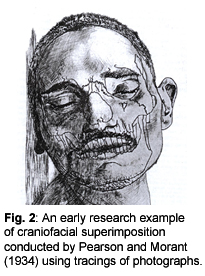 Craniofacial superimpositions were initially conducted using tracings of skulls and faces made from photographs (see e.g., Fig. 2). The first forensic application of the method was in this context (see Glaister and Brash, 1937). In more recent times, methods have moved solely to the comparison of photographs (Sen, 1962; Webster, 1955) and then to video images (Brown et al., 1978; Helmer and Gruner, 1977; Snow, 1976). Video-superimposition is now the most frequently employed method, and involves mixing a video image of a skull with a photograph of the person in question (usually also captured as a video image) to determine the degree of anatomical correspondence (see Fig. 1).
Craniofacial superimpositions were initially conducted using tracings of skulls and faces made from photographs (see e.g., Fig. 2). The first forensic application of the method was in this context (see Glaister and Brash, 1937). In more recent times, methods have moved solely to the comparison of photographs (Sen, 1962; Webster, 1955) and then to video images (Brown et al., 1978; Helmer and Gruner, 1977; Snow, 1976). Video-superimposition is now the most frequently employed method, and involves mixing a video image of a skull with a photograph of the person in question (usually also captured as a video image) to determine the degree of anatomical correspondence (see Fig. 1).
By varying the opacity levels of one video image and superimposing it on the other using video effects (e.g., wipes and fades) the degree of match between the skull and face can be assessed. Clearly, for a match to be entertained as authentic the soft tissue profiles of the face must encompass the entirety of the skull (Taylor and Brown, 1998), and major features must lie at the appropriate corresponding regions (lips over teeth, eyes within orbits, nose over nasal aperture etc.). Soft tissue depths may be used to evaluate the fit of the face with a skull (Helmer, 1984), as well as other more specific relationships, including: the position of the temporal line of the skull with that of the soft tissue, the position of the endo- and ecto-canthions with their relative ligamentous attachments to the bone, the position of the anterior nasal spine relative to the medial crus of the nose, and the shape of the chin in relation to the underlying mandible (for more details see: Austin-Smith and Maples, 1994).
In superimposition, it is extremely important that the orientation of the skull matches, as close as possible, the orientation of the face in the photograph (Taylor and Brown, 1998). The photography conditions between the two image sets (i.e., original photographs and video of the skull) should also be as similar as possible. A failure to closely approximate any of these conditions (including lighting, distance from the camera and focal length of the lens) will result in inconsistencies between the skull and the face even if the two are, in fact, a correct anatomical match (Taylor and Brown, 1998). Negative images of the skull with positive images of the face have also been used to enhance the visualization of the superimposition and facilitate skull-face comparison (Glaister and Brash, 1937).
Presently, it is not possible to draw firm statements concerning the overarching performance of superimposition methods because formal published studies on the accuracy and reliability of the methods have been infrequent, have used small samples, and have often not been replicated. This is in part due to the time intensive nature of such studies. So far, research indicates that superimposition is useful as an exclusion tool (i.e., determining to whom the skeletal remains do not belong; see Ubelaker, 2002) and that errors are reduced with the use of two or more views (i.e., frontal and profile). In perhaps the most comprehensive study so far conducted, Austin-Smith and Maples (1994) found that, when comparing three skulls to frontal and profile views of 97 persons, false positive or incorrect identification rates were 0.6%. Only one false positive superimposition result has been reported in the scientific literature in relation to forensic casework (see Dorion, 1983), however, this does not guarantee the lack of any other occurrences due to possible publishing bias.
Facial Approximation
As discussed above, facial approximation methods are regarded to be less reliable than craniofacial superimposition techniques since they deal with face prediction. Although these methods first developed in Europe (see Eggeling, 1913; His, 1895; Kollmann and Buchly, 1898; Merkel, 1900), the first written account of facial approximation methods employed for forensic casework comes from the United States (see details provided by Wilder and Wenworth, 1918).
From their initial conception, facial approximation methods have been controversial (Eggeling, 1913; Gerasimov, 1968; Montagu, 1947; Suk, 1935). They have also heavily relied on mean soft tissue depth data of the face (see His, 1895; Kollmann and Buchly, 1898; Gerasimov, 1955; Krogman and Iscan, 1986; Prag and Neave, 1997; Wilkinson, 2004 and Fig. 3), with all major facial approximation methods depending on soft 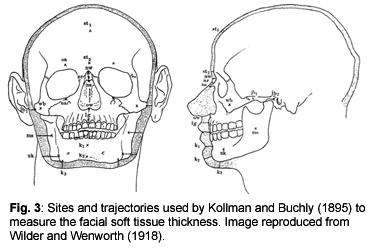 tissue depths and face anatomy to some degree (Stephan, 2006; see also Gerasimov, 1955; Ullrich, 1958). The frequently propounded view that some methods rely on the face anatomy, but others on the soft tissue depths alone, is inaccurate. Gerasimov (who is often cited in favor of the anatomical methods) used mean soft tissue depth values for his approximations (see figures provided in Gerasimov, 1955; Ullrich, 1958) and valued them so highly that he undertook his own needle puncture studies on fresh cadavers to measure them for his own work (Gerasimov, 1955).
tissue depths and face anatomy to some degree (Stephan, 2006; see also Gerasimov, 1955; Ullrich, 1958). The frequently propounded view that some methods rely on the face anatomy, but others on the soft tissue depths alone, is inaccurate. Gerasimov (who is often cited in favor of the anatomical methods) used mean soft tissue depth values for his approximations (see figures provided in Gerasimov, 1955; Ullrich, 1958) and valued them so highly that he undertook his own needle puncture studies on fresh cadavers to measure them for his own work (Gerasimov, 1955).
There is wide agreement that the ultimate aim of facial approximation is to construct a face that can be purposefully and readily recognized as the person to whom the skull belonged. However, attainment of casework "success" should not be confused with the purposeful realization of this goal. Advertisements of facial approximations are typically accompanied by case descriptions in addition to the estimated face, which are likely to influence performance. Consequently, the success of the method in forensic contexts cannot be used as a measure of the ability of facial approximation methods to generate recognizable faces. Attainment of the method aims can only be verified under controlled conditions where confounding variables can be eliminated or minimized and non-targets must be used in the assessments (see Stephan, 2002a; Stephan and Henneberg, 2001). The demonstrated usefulness of facial approximation in forensic casework unquestionably illustrates the value of the method to act as a vehicle for recognition, but purposeful and reliable recognition of facial approximations in the absence of other influencing factors has yet to be demonstrated (Haglund and Reay, 1991; Stephan, 2003). It is also important to note here that for facial approximations to be successful in forensic casework potentially only one person needs to think they recognize the face. Thus, an argument exists that facial approximation methods need not be accurate or reliable (especially since identification universes of individuals with similar biological profiles who are also missing are often small). Of course, if facial approximation methods achieved purposeful recognition their value would be dramatically increased.
Often, the poor method performance observed in many studies is explained away as a result of limited practitioner experience. While this might be a contributing factor in some cases, the inaccuracies associated with the soft tissue prediction guidelines that are used, are more fundamental and hold much greater concern. Indeed, recent studies have confirmed that many soft tissue prediction guidelines used in facial approximation (and superimposition) perform poorly. For example, traditional methods of setting 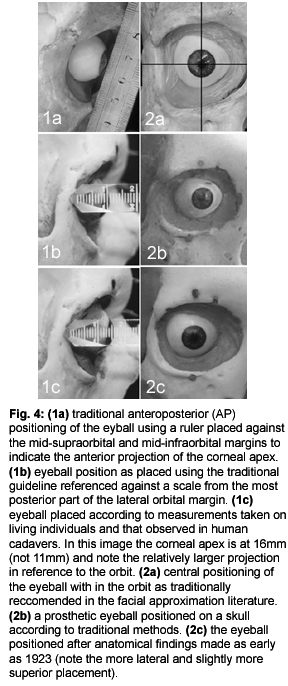 the position of the eyes have been found to contain large cumulative errors (Stephan et al. 2009; Stephan and Davidson, 2008; Stephan, 2002b; Wilkinson and Mautner, 2003; see Fig. 4). Similar findings go for prediction of the ear (Farkas et al., 2000), nose (Hoffman et al. 1991; Rynn and Wilkinson, 2006; Stephan et al., 2003) and mouth (Stephan, 2003b; Stephan and Murphy, 2008). Moreover, many untested subjective guidelines have been used in facial approximation and craniofacial superimposition despite the fact that quantified and well studied relationships exist in other disciplines and these latter guidelines often invalidate the former ones (Stephan and Devine, 2009; Stephan, 2010).Taken together, these findings undermine claims that overarching facial approximation methods are accurate, scientific, and based on solid anatomical foundations (see e.g., Wilkinson, 2010).
the position of the eyes have been found to contain large cumulative errors (Stephan et al. 2009; Stephan and Davidson, 2008; Stephan, 2002b; Wilkinson and Mautner, 2003; see Fig. 4). Similar findings go for prediction of the ear (Farkas et al., 2000), nose (Hoffman et al. 1991; Rynn and Wilkinson, 2006; Stephan et al., 2003) and mouth (Stephan, 2003b; Stephan and Murphy, 2008). Moreover, many untested subjective guidelines have been used in facial approximation and craniofacial superimposition despite the fact that quantified and well studied relationships exist in other disciplines and these latter guidelines often invalidate the former ones (Stephan and Devine, 2009; Stephan, 2010).Taken together, these findings undermine claims that overarching facial approximation methods are accurate, scientific, and based on solid anatomical foundations (see e.g., Wilkinson, 2010).
In light of the errors associated with recent methods, it is not surprising that facial approximations constructed using these methods are rarely recognized, or recognized at low rates (for accuracy studies see Snow et al., 1970; Stephan and Arthur, 2006; Stephan and Henneberg, 2001; Stephan and Henneberg, 2006; Stephan et al., 2005; Wilkinson et al., 2006). As inaccurate prediction methods have been identified improvements are being made (see above cited studies), but the challenge remains to improve methods so much that correct and purposeful recognition of the predicted faces can be easily and reliably achieved (Stephan, 2009).
It is also worth noting here that facial approximations of hominids, while interesting, cannot be justified on scientific grounds since the methods employed and/or the faces constructed cannot be verified/tested using antemortem facial appearances. Since little research has been directed towards establishing the most appropriate methods to predict these faces, even larger components of the method are left to the subjective interpretation than in forensic casework. Consequently, paleoanthropological facial approximations must be viewed using a strong degree of skepticism (Montagu, 1947; Stephan, 2003a).
Facial approximation methods have also been known by many other names previously. The most popular of these is “facial reconstruction”. There are two main problems with this term: i) the face is not reassembled from existing parts as reconstruction implies; and ii) reconstruction overemphasizes the exactness, reliability and scientific validity of the methods. Most practitioners now acknowledge that the term "facial approximation" is the most appropriate name for the prediction of facial appearances from the skull (George, 1987; Taylor, 2001; Haglund and Reay, 1991), although some continue to avoid its use due to its less sensational nature. The suitability of "facial approximation" is perhaps best demonstrated by Gerasimov who lucidly summarized the aim of the method as "approximation so close to the appearance of a living person that even an unknown individual could be identified" (Gerasimov, 1955, 1968, 1971).
Ridicule is sometimes directed at the term "facial approximation" since it is said that methods, if in the realms of scientific study, should be precise and exact. Besides being mistaken (see e.g., Popper, 1959; Kuhn, 1970; Feyerabend, 1999), this view expects too much of an elementary technique that, despite a lengthy history, is still emerging.
To reference the above content please cite:
Stephan CN (2011) Craniofacial identification: method background and overview. www.CRANIOFACIALidentification.com
References
Adams BJ, and Maves RC (2002) Radiographic identification using the clavicle of an individual missing from the Vietnam conflict. Journal of Forensic Sciences 48: 369-373.
Austin-Smith D, and Maples WR (1994) The reliability of skull/photograph superimposition in individual identification. Journal of Forensic Sciences 39:446-455.
Brown KA, Hollamby C, Clark BJ, and Reynolds L (1978) A video technique of cranio-facial photo-superimposition for identification. 8th Meeting of the International Association of Forensic Sciences, pp. 22-26.
Dorion RBJ (1983) Photographic superimposition. Journal of Forensic Sciences 28:724-734.
Eggeling vH (1913) Die Leistungsfahigkeit physiognomischer Rekonbstruktionsversuche auf Grundlage des Schadels'. Archiv fur Anthropologie 12:44-47.
Farkas LG, Forrest CR, and Litsas L (2000) Revision of neoclassical facial canons in young adult Afro-Americans. Aesthetic Plastic Surgery 24:179-184.
Feyerabend PK (1999) Knowledge, Science and Relativism. New York, Cambridge University Press.
George RM (1987) The lateral craniographic method of facial reconstruction. Journal of Forensic Sciences 32: 1305-1330.
Gerasimov MM (1955) Vosstanovlenie lica po cerepu. Moskva: Izdat. Akademii Nauk SSSR.
Gerasimov MM (1968) Ich suchte Gesichter. Gutersloh: C. Bertelsmann Verlag.
Gerasimov MM (1971) The Face Finder; Translated from the German by Alan Houghton Brodrick. London, Hutchinson & Co.
Glaister J, and Brash JC (1937) Medico-legal aspects of the Ruxton case. Baltimore: William Wood and Co.
Haglund WD, and Reay DT (1991) Use of facial approximation techniques in identification of Green River serial murder victims. The American Journal of Forensic Medicine and Pathology 12(2): 132-142.
Helmer R (1984) Schadelidentifizierung durch elekronicshe Bildmischung: Zugleich ein Beitrag zur Konstitutionsbiometrie und Dickenmessung der Gesichtsweichteile. Heidelberg: Krminalistik-Verlag.
Helmer RP, and Gruner O (1977) Vereingachte schadelidentifiziening nach dem super projektionsver fahren mit Hilfe einer video-anlage. Sectschrift Rectsmedizin 80:183-187.
His W (1895) Anatomische Forschungen uber Johann Sebastian Bach's Gebeine und Antlitz nebst Bemerkungen uber dessen Bilder. Abh MathPhysikal KI Kgl Sachs Ges Wiss 22:379-420.
Hoffman BE, et al. (1991) Relationship between the piriform aperture and interalar nasal widths in adult males. Journal of Forensic Sciences 36:1152-1161.
Kerley E (1978) Recent developments in forensic anthropology. Yearbook of Physical Anthropology 21:43-51.
Kollmann J, and Buchly W (1898) Die Persistenz der Rassen und die Reconstruction der Physiognomie prahistorischer Schadel. Archives fur Anthropologie 25:329-359.
Krogman WM, and Iscan MY (1986) The Human Skeleton in Forensic Medicine. Illinois: Charles C Thomas.
Kuhn TS (1970) The structure of scientific revolutions. Chicago, University of Chicago Press.
Merkel F (1900) Reconstruction der buste eines Bewohners des Leinegaues. Archives fur Anthropologie 26:449-457.
Montagu MFA (1947) A study of man embracing error. Technology Review 49:345-347.
Pearson K, and Morant GM (1934) The Wilkinson head of Oliver Cromwell and its relationship to busts, masks and painted portraits. Biometrika 25: 18-378.
Popper KR (1959) The Logic of Scientific Discovery. London, Hutchinson.
Prag J, and Neave R (1997) Making Faces: Using Forensic and Archaeological Evidence. London: British Museum Press.
Reichs KJ (1998) Forensic Osteology: Advances in the identification of human remains. Illinois: Charles C Thomas.
Rhine JS (1990) Coming to terms with facial reproduction. Journal of Forensic Sciences 35:960-963.
Rynn C, and Wilkinson CM (2006) Appraisal of traditional and recently proposed relationships between the hard and soft dimensions of the nose in profile. American Journal of Physical Anthropology 130:364-373.
Sen NK (1962) Identification by superimposed photographs. International Criminal Police Review 162:284-286.
Snow CC (1976) A video technique for skull-face superimposition. 28th Annual Meeting of the American Academy of Forensic Sciences.
Snow CC, Gatliff BP, and McWilliams KR (1970) Reconstruction of facial features from the skull: An evaluation of its usefulness in forensic anthropology. American Journal of Physical Anthropology 33:221-228.
Stephan CN (2002a) Do resemblance ratings measure the accuracy of facial approximations. Journal of Forensic Sciences 47:239-243.
Stephan CN (2002b) Facial Approximation: Falsification of globe projection guideline by exophthalmometry literature. Journal of Forensic Sciences 47:1-6.
Stephan CN (2003a) Anthropological facial "reconstruction" - Recognizing the fallacies, "unembracing" the error, and realizing method limits. Science and Justice 43:193-199.
Stephan CN (2003b) Facial approximation: An evaluation of mouth width determination. American Journal of Physical Anthropology 121:48-57.
Stephan CN (2006) Beyond the sphere of the English facial approximation literature: ramifications of German papers on Western method concepts. Journal of Forensic Sciences 51:736-739.
Stephan CN (2009) Craniofacial Identification: Techniques of Facial Approximation and Craniofacial Superimposition. In S. Blau & D. Ubelaker (eds): Handbook of Forensic Anthropology and Archaeology. Walnut Creek: Left Coast Press, pp. 304-321.
Stephan C N (2009) The accuracy of facial 'reconstruction': a review of the published data and their interpretive value. Minerva Medicolegale 129: 47-60.
Stephan, CN. (2010) The human masseter muscle and its biological correlates: a review of published data pertinent to face prediction. Forensic Science International 201: 153-159
Stephan CN, and Arthur RS (2006) Assessing facial approximation accuracy: how do resemblance ratings of disparate faces compare to recognition tests? Forensic Science International 159S:S159-S163.
Stephan CN, and Davidson PL (2008). The Placement of the Human Eyeball and Canthi in Craniofacial Identification. Journal of Forensic Sciences 53: 612-619.
Stephan CN, and Devine M (2009) The superficial temporal fat pad and its ramifications for temporalis muscle construction in facial approximation. Forensic Sceince International 191: 70-79.
Stephan CN, Huang AJR, and Davidson PL (2009). Further evidence on the anatomical placement of the human eyeball for facial approximation and craniofacial superimposition. Journal of Forensic Sciences 54: 267-269.
Stephan CN, and Henneberg M (2001) Building faces from dry skulls: Are they recognized above chance rates? Journal of Forensic Sciences 46:432-440.
Stephan CN, and Henneberg M (2006) Recognition by facial approximation: case specific examples and empirical tests. Forensic Science International 156:182-191.
Stephan CN, Henneberg M, and Sampson W (2003) Predicting nose projection and pronasale position in facial approximation: A test of published methods and proposal of new guidelines. American Journal of Physical Anthropology 122:240-250.
Stephan CN, and Murphy SJ (2008). Mouth Width Prediction in Craniofacial Identification: Cadaver Tests of Four Recent Methods, Including Two Techniques for Edentulous Skulls. Journal of Forensic Odonto-Stomatology 27: 2-7.
Stephan CN, Penton-Voak IS, Clement JG, and Henneberg M (2005) Ceiling recognition limits of two-dimensional facial approximations constructed using averages. In JG Clement and M Marks (eds.): Computer Graphic Facial Reconstruction. Boston: Academic Press, pp. 199-219.
Stewart TD (1979) Essentials of forensic anthropology: Especially as developed in the United States. Illinois: Charles C Thomas.
Suk V (1935) Fallacies of anthropological identifications. Publications de la Facultae des sciences de l'Universitae Masaryk 207:3-18.
Taylor KT (2001) Forensic Art and Illustration. Boca Raton, CRC Press.
Taylor JA, and Brown KA (1998) Superimposition techniques. In JG Clement and DL Ranson (eds.): Craniofacial Identification in Forensic Medicine. London: Hodder Arnold, pp. 151-164.
Ubelaker DH (2002) Cranial Photographic Superimposition. In CH Wecht (ed.): Forensic Sciences. New York: Matthew Bender, Inc., pp. 3-38.
Ullrich H (1958) Die methodischen Grundlagen des plastischen Rekonstruktionsverfahrens nach Gerasimov. Zeitschrift fur Morpholologie und Anthropologie 49:245-258.
Webster G (1955) Photography as an aid in identification: the Plumbago Pit case. Police Journal 28:185-191.
Welcker H (1883) Schiller's Schadel und Todtenmaske, nebst Mittheilungen uber Schadel und Todtenmaske Kant's. Braunschweig: Viehweg F and Son.
Welcker H (1888) Zur Kritik des Schillerschadels. Archives fur Anthropologie 17:19-60.
Wilder HH, and Wenworth B (1918) Personal identification: Methods for the identification of individuals, living or dead. Boston: Gorham Press.
Wilkinson C (2004) Forensic Facial Reconstruction. Cambridge: Cambridge University Press.
Wilkinson C (2010) Facial reconstruction - anatomical art or artistic anatomy? Journal of Anatomy 216: 235-250.
Wilkinson C, Rynn C, Peters H, Taister M, How Kau C, and Richmond S (2006) A blind accuracy assessment of computer-modeled forensic facial reconstruction using computed tomography data from live subjects. Forensic Science, Medicine, and Pathology 2:179-187.
Wilkinson CM, and Mautner SA (2003) Measurement of eyeball protrusion and its application in facial reconstruction. Journal of Forensic Sciences 48:12-16.
